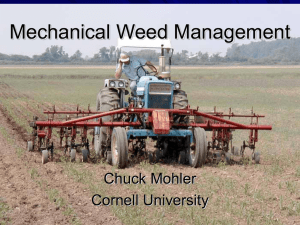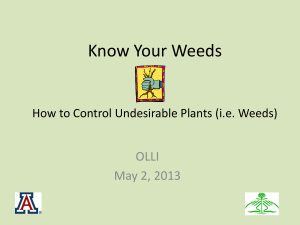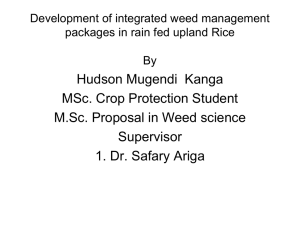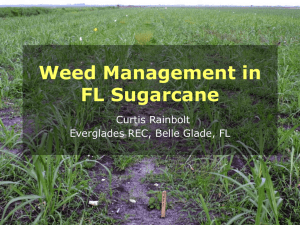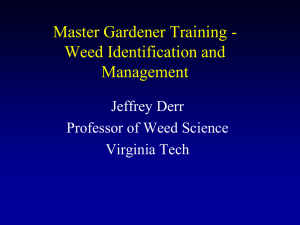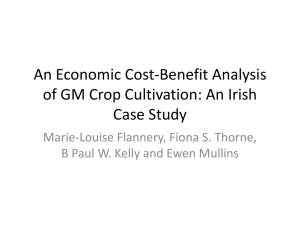Organic Weed Management - Sustainable Organic Horticulture
advertisement
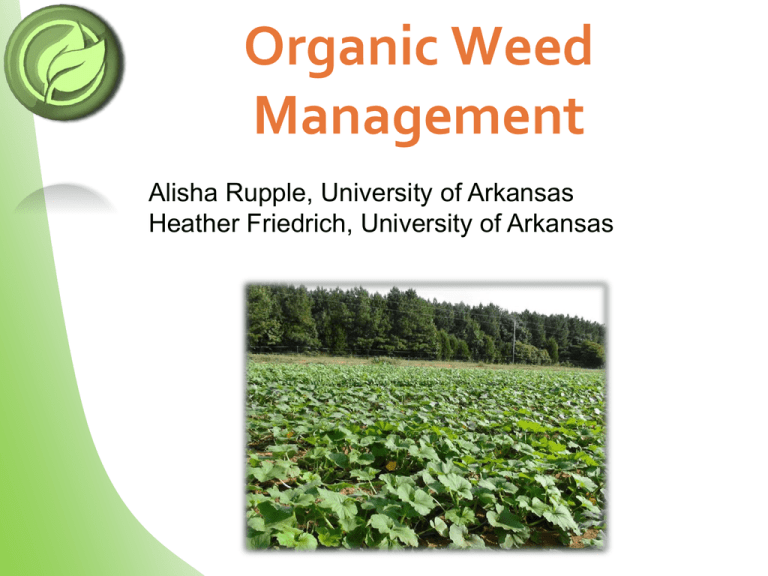
Organic Weed Management Alisha Rupple, University of Arkansas Heather Friedrich, University of Arkansas Weeds: Top Issue for Organic Farmers Successful Management Requires Multiple approaches Continual effort Knowledge of the biology of weeds species Reproduction, lifecycle, establishment annual, perennial, wandering perennial, broadleaf, grass Cornell Organic Weed Database, www.css.cornell.edu/WeedEco/WeedDatabase /index2.html Basic Weed Ecology Weeds are nature’s way of keeping bare ground covered and increasing biodiversity Dynamic system involving the interaction of weeds, crops, humans and environment Factors affecting weed ecology are identical to those affecting crop ecology: Light, temperature, water, pH, nutrients, organic matter, insects and diseases, etc Weed Crop Humans Natural environment Impact of High Weed Pressure Compete with crops for nutrients, water, and light Reduced yields Lower crop quality Harbor pest insects and diseases Increase irrigation costs But, complete elimination of weeds is unnecessary Weed numbers or size Multiple Prevention and Elimination Strategies Cultural Mechanical Biological Chemical (organically approved) “Many hammers approach.” Liebman and Gallandt, 1997 “Organic weed management practices” Crop Rotations on Organic Farms, Mohler & Johnson, 2009 Practice Effect Tillage Kills growing weeds; damages perennial roots & rhizomes; buries seeds too deeply to emerge; brings weed seeds to surface. Post-planting cultivation Removes weeds from the crop. Stale seedbed Flushes weeds from the soil before planting. Organic fertility sources Favor crops over faster-growing weeds due to slow release of nutrients. Drip irrigation Directs water to the crops rather than to weeds. Mulch Smothers weeds: delays emergence of weeds Using transplants Competitive advantage to crop Competitive cultivars Improves competitive ability of crop against weeds. Increase plant density Suppress weeds by shading Rapid cleanup after harvest Prevents seed set by residual weeds. Cover crops Suppress weeds, improves soil health Cultural Strategies Buy quality crop seed with low/no weed seeds present Do not allow weeds to form seed Thoroughly compost (>130°F for ≥15 days) all manure and plant residues to ensure destruction of weed seed Stale seedbed technique Prepare soil for planting and bring weed seeds to the surface; allow weeds to germinate, kill weeds with light tillage/minimal soil disruption. May be repeated. Plant main crop. Cultural Practices Improve crop competitiveness Improve soil tilth, aeration, and fertility to optimize crop growth Increase crop density through narrow row spacing and increased seeding rate Use transplants, rather than seed, when possible Plant at optimal soil temperatures to prevent slow germination of crop Choose competitive crop cultivars Manage fertility according to crop needs; avoid excess application Cultural Practices Reduce weed numbers Mulch (wood chips, mow and blow, paper, living, plastic, etc) Use weed-suppressive cover crops Quick germinating, high biomass Field with high weed pressure may warrant full year of cover cropping and fallow to reduce weeds Crop rotations altering narrowly spaced crops with closely spaced crops, shallow rooted/deep rooted crops, cold/warm season crops Intercrop Clover underseeded in sweetcorn Mulch • Prevent seeds from germinating by blocking light, can smother out some weeds • Conserve water, minimal soil disruption • Use local resources: straw, fabric, wood, newspaper, plastic • Be careful of weed seeds in straw or hay • Avoid hay, unless you know its free of weeds • • Especially good for perennial systems: blueberries, blackberries, flowers, trees Living mulches – ie constant cover of clover on orchard floor Wood chips Shredded paper Leaves Straw Cover Crops • Smother weeds by out- competing for light, water, nutrients • Release allelopathic chemicals that suppress weed germination • May reduce weed emergence by 75-90% • e.g. sudan grass, buckwheat, annual rye grass, sesbania, many more Field pea-oatmustard cover crop Managing Cover Crops Profitably, 3rd ed. SARE www.sare.org/publications/covercrops/covercrops.pdf Red Clover crops profitably. 3rd ed. SARE Crop Rotations • Weeds tend to infest crops with similar life cycles • Change crop ecology: shallow/deep roots, cold/warm season, row/drilled crops, foliage density, and heavy/light feeders Change cultural practices: cultivation, mowing, fertilization, herbicide application, and planting/harvest dates 10 Year Rotation Scheme Alex and Betsy Hitt, Chapel Hill NC; http://www.ssawg.org/hitt.html Y R Spring 1 Tomatos & leeks 2 Flowers-cool seas. Sudangrass-soyb. Oat-crimson cl. 3 Spring lettuce Flowers, summer 4 Squash 5 Flowers-overwintered 6 Peppers Wheat-crimson cl 7 Flowers -summer Oat-crimson clover 8 Mixed spring veg cowpeas 9 Flowers-overwintered Sudangrass-soyb. Oat-crimson clover 10 Flowers-summer Summer Fall Oat-crimson cl Rye-hairy vetch Fall planted flowers Sudangrass-soyb. Rye-hairy vetch Fall planted flowers Wheat-hairy vetch Physical and Mechanical Practices Mowing Prevents seeding Depletes storage reserves Better control for broadleaves Soil solarization Effective control of winter annuals Limited control of perennials Cost prohibitive on large acreages Avoid tillage deeper than 3” after solarization Hand weeding Cultivation Flaming Cultivation Should be shallow to lessen disturbance to weed seed bank Better for perennial and biennial control than annual weed control Wheel hoe Exhaust root system by depleting storage reserves Requires 6-8 timely treatments in yr 1, then 3-5 the following year Thoroughly clean equipment before moving it between fields to prevent weed transport Various hoes Potential Downsides of Cultivation Exposes bare ground: increased erosion, decreased biodiversity, speeds decomposition of OM, increases water run-off Major cause of soil compaction Cost: expensive equipment, fuel Should not be done in wet conditions Use Cultivation Wisely USDA-ARS research showed organic methods can increase OM more than conventional no-till Teasdale et al., 2007. Potential Long-Term Benefits of No-Tillage and Organic Cropping Systems for Grain Production and Soil Improvement. Agron J. 99:1297-1305 Negative effects of tillage may be offset by the use of cover crops and additions of organic matter (compost, manures, mulch, etc) Must still use caution to avoid negative effects of cultivation Type of Horticultural Cultivators Sustainable Vegetable Production from Start-Up to Market, Grubinger, 1999 Spyders™ Torsion weeders Spring hoe weeders Finger weeder Basket weeder Multiple-component weeder frame Brush weeder Rotary tilling cultivators Rear- or front-tine tillers Hand implements: pushpull hoes, hand scrapers, etc Other Cultivators Sustainable Vegetable Production from Start-Up to Market, Grubinger 1999, NRAES 104 Flaming Intense heat sears the leaf, causing the cell sap to expand and disrupt cell walls seedlings are most susceptible Broadleaf weeds are more susceptible than grasses May be used in wet soil conditions VIDEO: www.extension.org/pages/Video _Clip:_Backpack_Flame_Weed er_from_Vegetable_Farmers_an d_their_Weed_Control_Machine s Sustainable Vegetable Production from Start-Up to Market, Grubinger, 1999 Uses for Flaming Stale seedbed technique: Planting delayed after seed bed preparation (tillage, irrigation, etc) Flaming knockdowns flush of weed seedlings prior to planting Peak emergence technique: Crop seeded promptly after seedbed preparation Just before crop germinates, flaming used to kill weed seedlings Good method for direct-seeded, slow-germinating crops Glass or plastic can be used as a crop-germination indicator: crop grown under cover germinates 2-3 days before uncovered crop; flaming should occur when crop germinates under cover Post-emergent flaming: Emerged crops protected by: directing flame away from crops, shielding the crop, or flaming at a time when crop stems are resistant to heat Older plants able to recover from heat damage, while young seedlings are killed Flaming Tips Bigger weeds and wet weeds are harder to kill Target weeds while seedlings up to 3 to 4 leaves Avoid flaming with morning dew Light drying winds and hot days increase effectiveness Avoid flame deflection by soil clods or excessive dust = protect weeds Match equipment for your needs Save on fuel, time Make time for adjustments Burner placement, fuel pressure, tractor speed How much is enough? When you squeeze plant leaf between finger and thumb, want to see your thumb imprint = cells have burst and weed will die/setback Biological Control Practices Insects: may consume large numbers of weed seeds or feeding injury to plant or vector virus Thistle & adult thistle-head weevil, Rhinocyllus conicus Multiflora rose & rose rosette disease transmitted by fungi or a (mite) Selective grazing Sheep: clean fields after harvest Weeder geese: useful against grass weeds and in perennial systems Biofumigation Use of Brassica species (canola, Indian mustard) as cover crop or in rotation May be incorporated or left as residue Brassicas produce glucosinolates, which may by converted to cyanate compounds during decomposition Cyantes toxic to many bacteria, fungi, nematodes, insects, and germinating seeds Chemical Control Organic options Corn gluten meal (pre-emergent herbicide) Suppresses many common grasses and herbaceous weeds WeedBan™ and Corn Weed Blocker™ Look for non-gmo sources Commonly based on vinegar or lemon juice or clove oil ingredients (post-emergent burndown herbicide) • Perennials may require multiple applications Corrodes metal sprayer parts Burnout™, Bioganic™, AllDown ™, MATRAN™, and Weed Bye Bye™ Post-emergent chemicals are phytotoxic (burn plant tissue); use caution when applying in crops Organic herbicide in an orchard Cost can be decreased by knowing pattern of weed distribution (spot treatment v. overall application 12 Steps to Sustainable Weed Management – Mark Schonbeck Pre-season Planning Step 1. Know the weeds on your farm. Step 2. Plan cropping systems to minimize open niches for weeds. Step 3. Keep the weeds guessing. Step 4. Design the cropping system and select tools for effective weed control. Preventive (Cultural) Practices Step 5. Grow vigorous, competitive crops. Step 6. Put the weeds out of work – grow cover crops. Step 7. Manage the weed seedbank: minimize deposits and maximize withdrawls. Control Tactics Step 8. Knock the weeds out at critical times. No-till organic farm; Weed-free bed of weed-sensitive onion crop. Step 9. Utilize biological processes to enhance weed control. Step 10. Bring existing weeds under control before planting weed-sensitive crops and long-term perennial crops. Enhancing and Fine-tuning the Weed Management Strategy Step 11. Keep observing the weeds and adapt practices accordingly. Keep notes What is suitable for one crop may not be for another Step 12. Experiment and stay educated. Keep up on new developments and practices. Night time cultivation Soil solarization Others… Weed free bed of carrots Conclusion Using multiple approaches (“many hammers”) to manage weeds will yield greater impact than relying on a few practices. Develop a weed management strategy that is designed for the needs of your farm. Big Hammers -Competitive crops -Rotation -Cover Crops -Mulches -Weed predators -Livestock/grazers -Cultivation tools -Rollers/roller-crimper -Flamers -Growers Observation Little Hammers -Solarization -Organic herbicides -Bioherbicides -Soil microorganisms -Crop-weed interactions Resources The Sustainable Weed Control Rag, Mark Schonbeck, eOrganic, www.extension.org/article/18529, www.extension.org/article/18539 www.extension.org/article/18538 Sustainable Vegetable Production from Start-up to Market, Grubinger, 1999. NRAES-104 Crop rotation on Organic Farms: A Planning Manual, Mohler and Johnson, 2009. NRAES-177 Managing Cover Crops Profitably, 3rd ed. SARE www.sare.org/publications/covercrops/covercrops.pdf Michigan Field Crop Pest Ecology Management. Cavigelli et al. 2000, MSU Extension Bulletin E-2704 Cornell Organic Weed Management Website, www.css.cornell.edu/WeedEco/WeedDatabase/index2.htm l Acknowledgements This presentation address general organic production practices. It is to be to use in planning and conducting organic horticulture trainings. The presentation is part of project funded by a Southern SARE PDP titled “Building Organic Agriculture Extension Training Capacity in the Southeast” Project Collaborators • Elena Garcia, University of Arkansas CES Heather Friedrich, University of Arkansas Obadiah Njue, University of Arkansas at Pine Bluff Jeanine Davis, North Carolina State University Geoff Zehnder, Clemson University Charles Mitchell, Auburn University Rufina Ward, Alabama A&M University Ken Ward, Alabama A&M University Karen Wynne, Alabama Sustainable Agriculture Network
